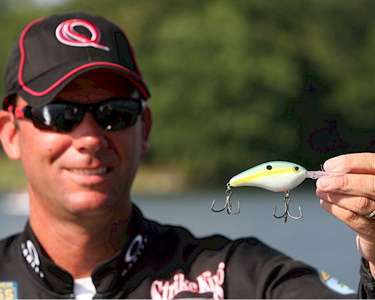
For most of us, changing the hooks out on a crankbait is typically an afterthought. Usually the thought of changing hooks occurs after a game-changing fish pulls off right at the boat.
The first thing you think is, "I should've changed the hooks!"
To Elite Series pros, changing the hooks on crankbaits is never an afterthought.
In fact, one pro in particular describes his hook changing practices as "fanatical," and it appears his fanaticism has paid off. "Having super-sharp hooks, and having the right hooks for that application, is too important to overlook," says reigning Toyota Tundra Bassmaster Angler of the Year Kevin VanDam. "That's the reason I went to Mustad and developed my own series of treble hooks, was to make sure that I had a hook that met each of the criteria I needed." Kevin explains that he prefers a treble hook that has a wide gap, but yet is strong and won't flex at the bend.
The hook has to be super-sharp for maximum sticking power; however, he cautions that the hook size has to be matched properly to the bait. "If you have the wrong size hook on your bait, it's not going to perform properly," VanDam explains. "If you're going to upsize your hooks to the next size up, you want to make sure that the front and rear hooks won't tangle with each other.
That's the biggest problem most people have." In addition to having a super-strong and sharp hook that's properly matched to the size of the crankbait, VanDam cautions that it's just as important to be efficient in changing them while on the water. "If you're fishing a rocky point where your hook points are getting banged up, you're not going to want to take the time to sharpen your hooks," he says.
"Instead, you'll just want to change the hooks out, but you want to be able to do it as fast as possible." Rather than using split-ring pliers for the task, Kevin enlists the aid of a pair of quality pliers that has a precise point. "I just start the hook that's on the bait, and put the new hook right on behind it by forcing the eye of the hook into the split ring," he says. "That's where the precise point of my needle-nose pliers comes in handy because I hold the hook just below the eyelet and drive it into the split ring as I'm forcing the other one off.
You're putting one on at the same time you're taking one off — you don't have to do the process twice." Kevin admits the he changes hundred, if not thousands, of hooks each year using this exact process, by eliminating a step he has found that it saves a tremendous amount of time over the course of a day.
"It's going to allow you to spend a lot more time casting rather than sitting in the bottom of your boat messing with hooks," he says. "In a tournament day, you might make a dozen extra casts as a result of the time you've saved. "That adds up to a dozen opportunities to put bass in the boat."
(Provided by Z3 Media)




